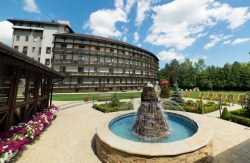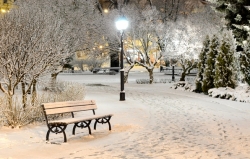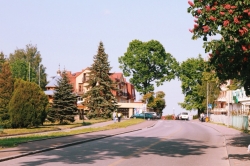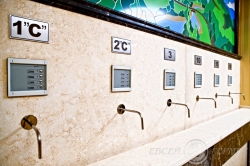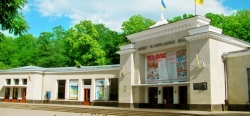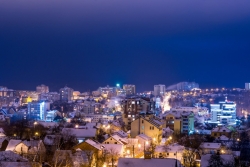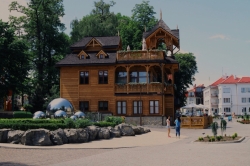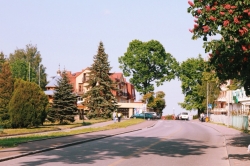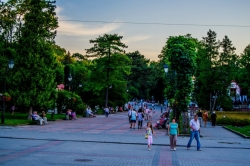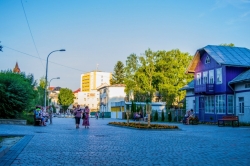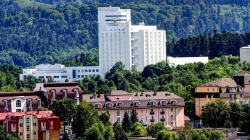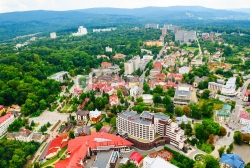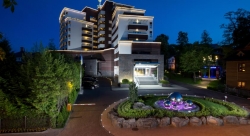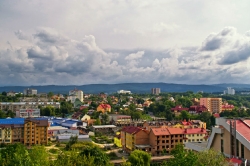Common description
Truskavets (Ukrainian: Трускавець, translit. Truskavets '; Polish: Truskawiec) is a city in western Ukraine's Lviv Oblast (region), near the border with Poland. It is designated as a city of oblast significance. Population: 29,516 (2013 est.)[1].
Truskavets is famous for its mineral springs, which have made it one of Ukraine's great resorts. For most visitors the primary goal is consuming the various 'local waters.' The most famous is the sulfur-scented, slightly saline 'Naftusia.' The town lies in an attractive little valley in the Carpathian foothills and is easily reached from L'viv by bus or train. The vast majority of tourists who come to Truskavets are either Ukrainian or Russian.
In 2000 a special economic zone (SEZ) was established in Truskavets for the period of 20 years.[2] Known as "Kurortopolis Truskavets", the SEZ offers various tax privileges for businesses and investors. Some 13 investment projects have been approved under its framework, with the majority focusing on health and medical treatment.[3]
Truskawiec was first mentioned in 1427. At that time the village was property of Kings of Poland, and was located in Ruthenian Voivodeship. First baths were opened here in 1827 when Truskavets, with the rest of Galicia, was part of the Austrian Empire. In 1836 Jozef Micewski, with support of Agenor Goluchowski, initiated construction of the spa complex. In 1853, the village was visited by Archduke Karl Ludwig of Austria. In 1911, a rail station was opened here, and by 1913, the town was receiving some 5,000 visitors per year.
Following the collapse of the Austro-Hungarian Empire, the ensuing Polish-Ukrainian armed conflict and an eventual Polish-Soviet partition of Ukrainian lands, Truskawiec fell under the jurisdiction of the Polish state. During the short-lived period of Polish administration 1920-1939, Truskavets emerged as popular spa destination. In the 1920s and 1930s, almost 300 hotels, villas and guest houses were built here. The town was awarded three gold medals as the country's best spa resort. A number of notable Polish personalities visited Truskavets during that era: Stanislaw Wojciechowski, Józef Piłsudski, Leon Sapieha, Wincenty Witos, Ignacy Daszynski, Eugeniusz Bodo, Adolf Dymsza, Julian Tuwim, Stanislaw Witkiewicz, Bruno Schulz, Zofia Nalkowska, Stanisława Walasiewicz, Halina Konopacka and Janusz Kusocinski.
On August 29, 1931, Vasyl Bilas and Dmytro Danylyshynt, two activists of the Organization of Ukrainian Nationalists assassinated Tadeusz Hołówko, a Polish cabinet minister vacationing in Truskavets. In response, the Polish government ordered another wave of "pacifications", a repression campaign against ethnic Ukrainians. This only deepened the resentment against the Polish state authorities and ethnic divide among the local population
Truskavets is famous for its mineral springs, which have made it one of Ukraine's great resorts. For most visitors the primary goal is consuming the various 'local waters.' The most famous is the sulfur-scented, slightly saline 'Naftusia.' The town lies in an attractive little valley in the Carpathian foothills and is easily reached from L'viv by bus or train. The vast majority of tourists who come to Truskavets are either Ukrainian or Russian.
In 2000 a special economic zone (SEZ) was established in Truskavets for the period of 20 years.[2] Known as "Kurortopolis Truskavets", the SEZ offers various tax privileges for businesses and investors. Some 13 investment projects have been approved under its framework, with the majority focusing on health and medical treatment.[3]
Truskawiec was first mentioned in 1427. At that time the village was property of Kings of Poland, and was located in Ruthenian Voivodeship. First baths were opened here in 1827 when Truskavets, with the rest of Galicia, was part of the Austrian Empire. In 1836 Jozef Micewski, with support of Agenor Goluchowski, initiated construction of the spa complex. In 1853, the village was visited by Archduke Karl Ludwig of Austria. In 1911, a rail station was opened here, and by 1913, the town was receiving some 5,000 visitors per year.
Following the collapse of the Austro-Hungarian Empire, the ensuing Polish-Ukrainian armed conflict and an eventual Polish-Soviet partition of Ukrainian lands, Truskawiec fell under the jurisdiction of the Polish state. During the short-lived period of Polish administration 1920-1939, Truskavets emerged as popular spa destination. In the 1920s and 1930s, almost 300 hotels, villas and guest houses were built here. The town was awarded three gold medals as the country's best spa resort. A number of notable Polish personalities visited Truskavets during that era: Stanislaw Wojciechowski, Józef Piłsudski, Leon Sapieha, Wincenty Witos, Ignacy Daszynski, Eugeniusz Bodo, Adolf Dymsza, Julian Tuwim, Stanislaw Witkiewicz, Bruno Schulz, Zofia Nalkowska, Stanisława Walasiewicz, Halina Konopacka and Janusz Kusocinski.
On August 29, 1931, Vasyl Bilas and Dmytro Danylyshynt, two activists of the Organization of Ukrainian Nationalists assassinated Tadeusz Hołówko, a Polish cabinet minister vacationing in Truskavets. In response, the Polish government ordered another wave of "pacifications", a repression campaign against ethnic Ukrainians. This only deepened the resentment against the Polish state authorities and ethnic divide among the local population
Truskavets on map
-3°C




